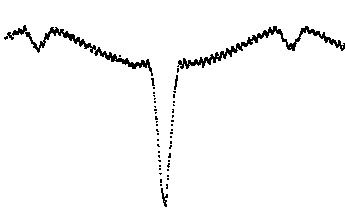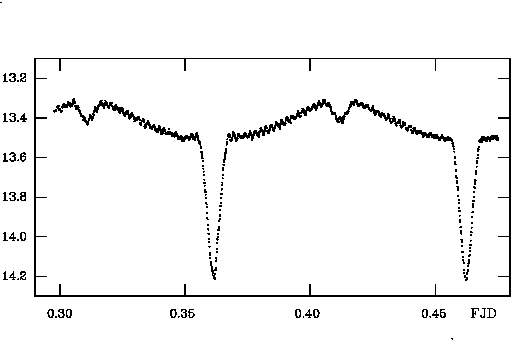Xcov 17 Scientific Justification


Subdwarf B (sdB) stars are extreme horizontal branch stars which are believed to comprise 0.5 solar masses of He (and the usual admixture of metals) with a very thin (less than 2% by mass) layer of H, chemically segregated from the He and heavier elements by settling in the star's large gravitational field. The evolution of the progenitors of these stars is not well understood, relying on unknown mass loss mechanisms on the giant branch to remove almost all the H envelope of the progenitor at the same time as increasing the He core to the mass needed to ignite He burning in the He flash. Fortunately the discovery in the past few years of pulsating sdB stars (the EC14026 stars) (Kilkenny et al. 1997 and its 3 companion papers in the same issue of MNRAS) has opened the prospect of using asteroseismology to examine the interiors of these stars. An example of this approach is the study of the pulsating sdB star PB8783 by O'Donoghue et al. (1998). In the long term, measuring the evolution timescale of the star through pulsation period changes as is being done for several of the variable white dwarfs, will provide the first measurement of the rate of core He burning in any known evolved star.
PG1336-018 is a pulsating sdB star in a very short-period (2.4 hr) eclipsing binary system remarkably similar (except for the addition of pulsations) to the previously unique system HW Vir (Wood et al. 1993). Its companion is probably a main-sequence star of spectral type M4 or M5. The light curve (Figure 1) shows partial eclipses (i~81 degrees) and a substantial reflection effect (Kilkenny et al. 1998). Analysis shows that PG1336-018 has pulsation periods at 184.0 sec (amp ~0.01 mag) and 141.3 sec (0.005 mag) although there is an indication in the discovery data of several other pulsations with amplitudes of the order of 0.003 mag or less.
We propose to observer PG1336-018 with the Whole Earth Telescope (WET). The WET (Nather et al. 1990) is a collaboration of astronomers who agree to observe a target variable in such a way that observations can continue around the globe, from site to site, 24 hours a day. The continuous coverage offered by the WET is the only way to separate real rotationally-split modes from aliases caused by data gaps, or in this case, orbital sidebands. The increased data density also provides a significantly higher signal to noise ratio than is possible from a single site observing over a similar timespan. We find we typically need 2 weeks of coverage from the network to obtain a resolution and signal to noise ratio high enough for accurate mode identification. With a Vmag of 13.4, PG1336 is easily visible from 1m class telescopes, but the real observed signal is not the mean level of the star, but the deviations around that mean due to the stellar pulsations. With the fairly low amplitudes of this star (we are expecting modes of 0.003 mag or less), 2m class telescopes are really more appropriate. We are asking for time at the following sites: Nordic Optical Telescope 2.6m, Beijing Astrophysical Observatory 2.16m, McDonald 2.1m, Observatoire de Haute Provence 1.9m, SAAO 1.9m, Moletai 1.65m, Itajuba 1.6m, CTIO 1.5m, Calar Alto 1.2m, Mt. John 1.0m, Siding Spring 1.0m, Naini Tal 1.0m, Wise Observatory 1.0m, and Mt. Suhora 1.0m.
The goals of the WET PG1336 observations are to resolve fully the pulsation frequencies present and to identify the quantum numbers of the pulsation modes. We will use this information to model the interior structure of this star and further our understanding of this very interesting class of objects. The WET data should allow us to identify any existing rotationally-split modes and find more low-amplitude modes than were found in the discovery paper. The more modes there are, the more chance there is of identifying their quantum numbers and the more constraints can be placed on the structure of the ESS.
It is very likely that, in a binary this close, the rotation of the pulsator
will be phase-locked to the orbital motion. If so, non-radial pulsations
will be split according to the Ledoux formula:
f_{klm} = f_0 + m*(1-C_{lk})*F_{rot}
with Frot=1/2.4hr, the star's rotation frequency. The rotational splitting
coefficient C(kl) is a function of the structure of the star, and is estimated
from pulsation models for the sdB stars developed by Kawaler (ISU) to be
between 0.05 and 0.4, significantly NON-zero. It is inevitable from the shape
of the light curve (eclipses, reflection effect) that a frequency splitting
equal to the orbital frequency will be seen in the pulsations. But rotational
splitting would be resolved from this in ~3-20 binary periods provided C(kl)
is in the expected range. Detection of rotational splitting would constitute
the first measurement of rotational splitting in an sdB star, also helping
to resolve the ambiguity of radial vs. non-radial pulsations in these stars.
We may also be able to model the pulsations during the eclipse to identify the spherical harmonic quantum number. About fifty eclipses over five days, combined with an accurate ephemeris, will reduce the number of free parameters in modelling and may allow us to identify uniquely the spherical harmonic associated with the pulsation. A difficulty with this approach is that the pulsations occur on roughly the same time scale as the eclipses so that there are only a few pulsations per eclipse. Success, though, will provide an additional, independent method of mode identification.
The data reduction will require some care as it is not possible simply to remove atmospheric extinction as a low frequency term, due to the 2.4 hr period of the reflection effect. We have shown, however we can remove it with a sine wave and its first harmonic to a good approximation. We thus expect a WET run on PG1336-018 will produce new keys to the insides of the EHB stars.
Cox J.P., 1980, Theory of Stellar Pulsation, Princeton University
Press, Princeton, NJ
Kilkenny D., et al., 1994, MNRAS, 267, 535
Kilkenny D., et al., 1997, MNRAS, 285, 640
Kilkenny D., et al., 1998, MNRAS, 296, 329
Koen C., et al., 1998, MNRAS, 296, 317
Nather, R.E., et al., 1990, ApJ, 361, 209
O'Donoghue D., et al., 1998, MNRAS, 296, 296
Winget D.E., et al., 1991, ApJ, 378, 326
Winget D.E., et al., 1994, ApJ, 430, 839
Wood J., et al., 1993, MNRAS, 261, 103

Send comments to wetmaster. Last updated on 28 Jan 1999.